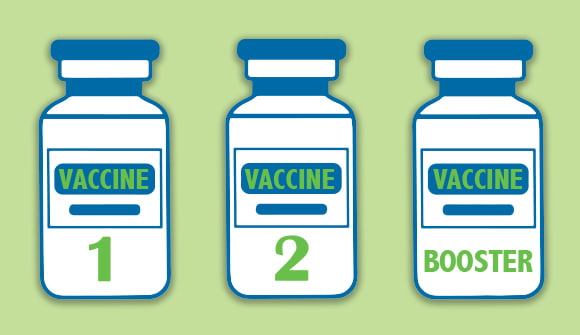Fighting ‘flurona’
Is the latest pandemic buzzword cause for concern?
Article Date:

Reports of “flurona,” a simultaneous infection of influenza and the coronavirus, have been making headlines in early 2022. With flu season settling in and the omicron variant rapidly spreading, many people are wondering how concerned they should be about getting both viruses at the same time.
Shalika Katugaha, MD, system medical director of Infectious Diseases at Baptist Health, shared what to know about “flurona” and how the community can protect themselves.
What is “flurona”?
“'Flurona' is not a new COVID-19 variant or even a new condition,” said Dr. Katugaha. “The informal term describes a coinfection of both influenza and coronavirus.”
Dr. Katugaha further explained, “Having the flu and COVID-19 at the same time has been a possibility since the pandemic began, and the U.S. actually saw its first case of ‘flurona’ in 2020. The reason we’re hearing so much about it now is because the coinfection is becoming more common. We had a record low flu season last year because of social distancing and rigorous safety precautions, but this year is different. We are in the midst of an active flu season and high COVID-19 activity with the omicron variant surge, leading to increased chances of contracting both viruses at the same time.”
How common is it?
“We will continue to see more of these coinfections, as well as more cases of COVID-19 coinfections with other common viruses such as respiratory syncytial virus (RSV) and human metapneumovirus (HMPV),” said Dr. Katugaha. “Essentially, as long as we experience high COVID-19 activity, we will see the virus partner with others to create dual or simultaneous infections.”
Who is at greatest risk?
Individuals who are unvaccinated against both flu and COVID-19 are at highest risk of contracting the coinfection and experiencing complications.
Aside from vaccination status, other factors can increase the chances of severe illness. At-risk groups include:
- Children
- The elderly (over 65)
- Immunocompromised individuals
- Pregnant women
- Those with underlying comorbidities
What are the symptoms?
Both the flu and COVID-19 are respiratory viruses, so their presenting symptoms are very similar. Because of that, “flurona” can be difficult to distinguish.
Symptoms commonly related to both viruses include:
- Body aches
- Cough
- Fatigue
- Fever
- Headache
- Runny nose
- Sore throat
How can you confirm a “flurona” diagnosis?
Aside from testing, there’s no clear way to tell whether you have the flu, COVID-19 or both.
“If you get a COVID-19 test, you could very well miss a flu diagnosis,” said Dr. Katugaha. “That’s why ‘flurona’ is something we as medical experts can’t fully track or give accurate numbers for right now. We’d ultimately be underestimating because most diagnoses are only being made when someone is admitted to the hospital or otherwise tested for both.”
Is "flurona” more dangerous?
Having “flurona” doesn’t necessarily mean an individual will get twice as sick, as the severity of the coinfection depends on the person’s overall health.
“We have a quote in the infectious disease community,” said Dr. Katugaha. “'It’s not the pathogen, it’s the host.' This means it’s not the virus, or even the number of viruses, that matters. What ultimately matters is the individual who gets it.”
Dr. Katugaha continued, “If you’re young, healthy and vaccinated against both viruses, there’s no reason to think that you would be twice as sick if you got ‘flurona.’ You might experience only mild symptoms. If you’re unvaccinated and have comorbidities, then having both viruses together could absolutely make you doubly sick and even require hospitalization.”
Are certain COVID-19 variants more prone to coinfections?
“We don’t have any data that confirms whether coinfection is more likely with one COVID-19 variant over another,” said Dr. Katugaha. “Omicron is our dominant strain right now, and it also happens to be an active flu season. That’s why we’re seeing more coinfections with omicron versus delta. It’s just the timing.”
Is it safe to take treatment for both viruses at the same time?
Each virus has different treatment options, so it’s important to get the right diagnosis (or diagnoses).
Antiviral medications for the flu, like oseltamivir (Tamiflu®), can shorten the course of illness and prevent complications like pneumonia.
There are also several antiviral medications to treat COVID-19, including remdesivir, molnupiravir and Paxlovid™.
“Taking antiviral therapies for both viruses at the same time is fine,” said Dr. Katugaha. “These drugs are directed to target either the flu or coronavirus and shouldn’t cause adverse side effects if taken at once. It’s also important to note that taking therapy for one virus won’t positively or negatively affect the other virus. As with anything, though, it’s important to talk about all treatment options with your doctor.”
What is the best way to prevent “flurona”?
Both the flu and coronavirus are transmitted through respiratory droplets, so wearing a mask, washing your hands frequently and maintaining social distance can help minimize infections.
However, the best way to prevent coinfection and serious illness is to get vaccinated against both viruses.
“It’s safe and effective for most people to get both vaccines at the same time, but it’s best to consult your primary care physician for individual guidance,” said Dr. Katugaha. “Don’t panic if you do contract one or both viruses, especially if you are already vaccinated. While the vaccine may not have prevented a breakthrough infection in your case, it is extremely likely to prevent severe disease.”
At Baptist Health, we want to help keep our community informed about COVID-19. For more information about COVID-19 vaccines, visit baptistjax.com/covid19vaccine. Click here to find a vaccination location near you.



